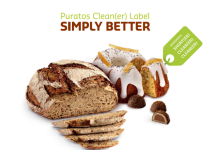The baked goods segment in India has been traditionally dominated by wheat-based products such as chapati, naan, puri, paratha and a variety of other bakery products such as biscuits, cookies, etc. However, Western baked products such as cakes, pastries and dessert mixes are now gaining much popularity and significance. This sector is a sunrise sector in India which holds strong growth potential driven by rising urbanization, increasing incomes, greater exposure to Western markets and wider penetration of organized retail.
As more and more consumers turn their preferences towards the organized sector when it comes to Western baked products, the demand for packaging too is growing for baked goods.
“People are moving from unorganized to organized sector so we are seeing demand for packaged goods,” said Dilip Radhakrishna, research analyst, Euromonitor International during his presentation at ‘Indulgence and Beyond,’ a seminar on patisserie organized by Puratos India at Mumbai’s ITC Grand Maratha hotel on 23 August 2017.
Demand for packaging in baked goods is also driven by emphasis on hygiene, especially among the millennials. This is giving rise to branded and stylishly packaged products and proliferation of specialty stores. “The new and empowered millennial consumers with higher disposable incomes and changing lifestyles are also more careful about hygiene and quality of food they consume,” Radhakrishna said.
Ranjana Sundaresan, food and drink analyst, Mintel said, “There is high acceptance of patisserie in India given our sweet tooth, but Indian consumers still prefer freshly baked goods over packaged products. However, our hectic lifestyles today call for a growing demand for convenient and innovative solutions. There is significant scope for packaged patisserie to cater to these needs.”
Not only did the audience get to know the trends in the bakery industry, but also about more technical aspects of packaging in baked goods, especially patisserie. Prabuddha Dasgupta, a veteran of the packaging industry, talked about a variety of solutions that were available for the bakers, artisans and other branded players in the market.
“Packaging is a celebration of food. From the baker’s oven to the dining table, it is the last thing your bread gets into and the first thing it comes out of. Between the two lies the story of packaging. It adds value to the product journey by preserving its freshness and providing information on its nutritive value through branding on the shops shelf,” said Dasgupta.
Dasgupta informed the audience that there is a wide range of laminates and bottom webs to protect and extend the shelf life of bakery products. There are also a range of film specifications and visual effects such as appealing high gloss effect, printing in up to 10 colors.
Paper-based packaging solutions are also gaining popularity. Paper-based baking trays are an environment-friendly alternative to plastic or foil trays. Made from corrugated, solid board or folding carton, baking trays are made from a renewable resource and can be recycled depending upon liners selected. These solutions are suitable for direct food contact, the trays are heat resistant and can be used safely in ovens. This provides maximum convenience for consumers who are able to cook the product in its packaging. Baking trays are available in a variety of shapes, sizes and colors and are suitable for both automated and manual packaging lines.
Solid board and folding carton cake boxes are typically used in bakeries and available in one and two piece designs. Dasgupta spoke about an interesting innovative cake box is called Torten Boy consisting of a tray and lid. The box can be opened from two sides allowing the cake to be removed horizontally rather than upwards. This avoids any difficulty removing the cake from the box and ensures there is no damage. Other commonly used boxes are 4 / 6 corner boxes for easy erection.
He also talked about the benefits of modified atmospheric packaging (MAP) for baked goods. Typical products that benefit from MAP are tortilla wraps, baguette, bagels, pita, naan bread and other types of bread. These products have a relatively low water content, the type of microbes that can cause spoilage are mainly moulds, as bacteria thrive in water.
MAP can also extend the shelf life significantly. With typical packaging, shelf life is usually less than 14 days at best. With MAP, one can extend shelf life by 40 plus days and thereby increase geographic market potential.
Finally, Dasgupta spoke on the issue of sustainability. He said sustainability is most often defined as meeting the needs of the present without compromising the ability of future generations to meet theirs.












